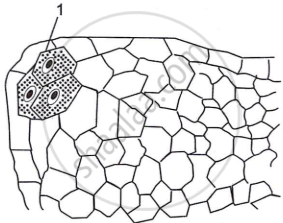Advertisements
Advertisements
Question
Discuss the role of cambium in the secondary growth of dicot stems.
Solution
Secondary growth is the characteristic of dicot stem because of the presence of open vascular bundles in stem — Activity of the Cambium :
(i) Formation of cambium ring: The vascular bundles of a dicot stem have strips of cambium in-between xylem and phloem which are known as intrafascicular cambium. During secondary growth, the cells of medullary rays at the level of intrafascicular cambium become meristematic activity and form strips of cambium called interfascicular cambium. The intra and interfascicular cambium join to form a complete ring called cambial ring or phellogen. The cells of vascular cambium are of two types, elongated spindle-shaped fusiform initials, and shorter isodiametric ray initials. Both appear rectangular in TS. Ray initials give rise to vascular rays. The activity of the cambial ring gives rise to secondary growth.’
(ii) Formation of secondary tissues: The fusiform cell of the cambial ring becomes active and starts cutting off new cells. The cells cut off on the outer side get differentiated into secondary phloem and are called secondary phloem. The cells cut off on the inner side form the elements of xylem which constitute secondary xylem. The secondary phloem consists of sieve tubes, companion cells, phloem fibres, and phloem parenchyma. Secondary xylem consists of pitted vessels, tracheids, xylem fibres, xylem parenchyma.
The cells of vascular cambium are of two types, elongated spindle-shaped fusiform initials, and shorter isodiametric ray initials. Both appear rectangular in TS. Ray initials give rise to


Fig. A Complete ring of vascular cambium formed by strips of intrafascicular cambium and interfascicular cambium; B, L.S. Vascular cambium showing fusiform and ray initials; C, formation of secondary vascular tissue mother cells; D, the beginning of secondary growth (mostly made-up of secondary vascular tissues) of dicot stem (diagrammatic); E, two-year stage of secondary growth of a dicot stem.
(iii) Secondary medullary rays: Ray initial cells of cambium form radially elongated narrow bands of living parenchyma cells passing through secondary xylem and secondary phloem and are called secondary medullary rays. The part of ray in secondary xylem is called xylem ray and the part present in secondary phloem is called phloem ray. These provide radial conduction of food from the phloem and water, mineral salts from xylem.
(iv) Annual rings: Activity of cambium is not uniform in those plants which grow in the regions where favourable climatic conditions (spring or rainy season) alternate regularly with unfavourable climatic conditions (cold winter or dry hot summer). In temperate climates, cambium becomes more active in spring and forms a greater number of vessels with wider cavities while in winter it becomes less active and forms narrower and smaller vessels. The wood formed in the spring is called springwood and that formed in dry summer or cold winter, autumn wood. These two woods appear together in the form of a concentric ring, in the transverse section of the trunk and this is known as annual ring i.e., the total wood (secondary xylem) produced in a year. The growth of successive years appears in the form of concentric or annual rings, each annual ring representing the year’s growth. The age of the plant can approximately be determined by counting the number of annual rings (Dendrochronology).
APPEARS IN
RELATED QUESTIONS
Why is non-cyclic photo phosphorylation considered as a non-cyclic pathway?
With the help of diagrams, name and describe the different types of placentation seen in angiosperms.
If the haploid number of chromosomes in a plant species is 20, how many chromosomes will be
present in the cells of the shoot tip?
Define: Actinomorphic symmetry
Draw a neat labelled diagram of L.S. of anatropous ovule.
Draw a neat labelled diagram of the vertical section of a monocot leaf.
The figure given below shows the early stage of the development of microsporangium.

Name the hypodermal cell labelled '1' which divides periclinally.
Draw a neat and well labelled diagram of T.S. of the mammalian ovary.
| Meena had grown Rose and China-rose plants in her garden. She collected pollen grains from China-rose plants and sprinkled them on the stigma of the Rose flowers, as she wanted to grow a hybrid variety of Rose. |
- Will this pollination give the desired results? Give a reason for your answer.
- What is geitonogamy? Why is it considered equivalent to cross-pollination in ecological context and self-pollination in genetic context?
